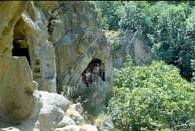|
 |
|
 |
| |
CAVE CITIES |
|
 |
|
 |
| |
Êàòåãîðèÿ: Itineraries |
Íîâîñòü îò: admin | 15.03.2007, 05:06

In the region of Goris (Syunik) there are interesting historical monuments - cave and rocky dwellings - so called karataks. The significant part of population of Syunik lived in them in the past. Numerous cave dwellings were, basically, in the gorges of the river Vorotan and its inflows. In the valley of the small river Vararak (Goris -get) there is a district of "Tsakeri-dzor" - the gorge of catacombs.
Most likely, the caves which are situated under firm covers of lavas were being formed in the result of washout of underlying softer and friable soils. People, finishing the cause of the nature, dug out and took out the ground; some of them plastered the walls with clay. Sometimes cave dwellings, with a view of protection, were made so high up in the precipice of the gorge, that it was difficult to reach them even for inhabitants: they climbed up keeping at the cord the end of which was attached to the threshold of the dwelling.
One of the cave cities is near the town of Goris. The houses were constructed here in the form of peaked, high (up to 40-50 meters) cones, mostly standing in groups. Each dwelling, as a rule,was divided by partition into two parts: tun - for residing people and gom - for cattle. Rocky apartments, as a rule, were without windows - they were illuminated only from the side of the entrance. Along the walls of dwelling part the big benches were cut down, and in goms - feeding troughs for cattle. Some of the caves were used as small pantries and barns. The cave city is many- tiered, and a roof of the bottom dwelling serves as an entrance platform for the upper dwelling. With the advent of metal instruments natural caves extended more and more and were reconstructed, forming rather big settlements.
Within twelve kilometers from Goris lies the ancient settlement of Khndzoresk abundant with the cave-cities . Dwellings were constructed as terrace, and the roof of one house served as a yard for another. From afar, the city is like a huge many- tiered house located on the slopes of the mountains. In the picture of a freakish composition of the settlement one dominating detail - the arch- leaps into the eye. Garlands of arches surround stepped slopes of mountains - they were cut out in the rocks, laid from stones, allocated among natural ledges. The chain of arches as though unites a heap of stones, rocks, and houses into a single whole. The Armenian builders could adapt the environment for creation of unique and amazingly harmonious architectural ensemble. Khndzoresk is one of the big villages of East Armenia. At the end of XIX century 4200 persons lived here, and at the beginning of XX century - 8300. In the settlement church St. Hripsime (1663) with a belltower and St. Tadevos (17th century) are preserved. Ruins of church Anapat are preserved, which had school and which was the center of education of Syunik. Two medieval monuments - springs of XVII century are intact as well.
The tomb of Mkhitar Sparapet is in Khndzoresk.
|
|
 |
|
 |

|
 |
|
| |
Ñ÷¸ò÷èê |
 |
|
| |
| Ïí: |
273 |
| Âò: |
375 |
| Ñð: |
165 |
| ×ò: |
161 |
| Ïò: |
234 |
| Ñá: |
233 |
| Âñ: |
391 |
| Âñåãî: |
639057 |
| Ðåêîðä: |
1604 |
| OnLine: |
4 |
|
 |
|
|

